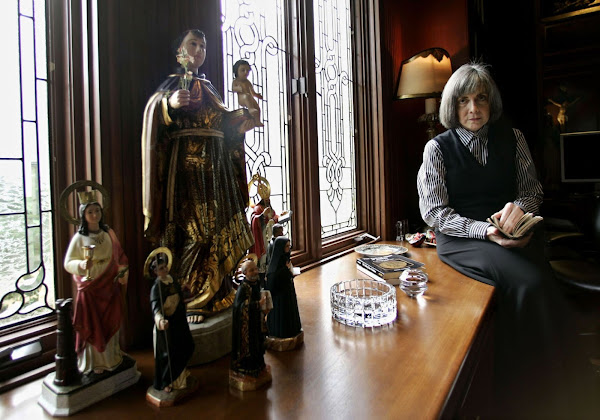Anne Rice, the author of the gothic novel Interview with the Vampire, among many many others in different genres, has died at the age of 80. You might have read the obituary, you might also have read her books, she was mighty popular; and for good reason.
The sad news of her passing prompted a memory to surface, one I don't believe I have talked about before. In one of her novels, Exit to Eden, a bdsm erotica novel from 1985 written under the nom de plume Anne Rampling, and later under her own name, there is an exquisite (her favorite word) excerpt that focuses on perfume perception.
The plot line goes like this: They call her the Perfectionist. A stunning, mysterious, and fearless sexual adventurer, Lisa is founder and supreme mistress of The Club—an exclusive island resort where forbidden fantasy meets willing flesh. A thrill-seeking photojournalist, Elliott risks his life daily in the most dangerous, war-torn regions on Earth. Now he has come to Paradise to explore his most savage and vulnerable sexual self, committed to the ultimate plunge into personal risk.
In the initial chapters, when Lisa and Elliot first play together, a mention of Chanel perfume is mentioned.
"Tall but not as tall as all the men were here. And there was that sweet, intoxicating scent of Chanel. No doubt about it. She was there. The woman in my life."
and elsewhere
"The perfume was Chanel, and it came in little waves, like with her pulse."
Chanel, but which Chanel perfume? At the time of printing, mid-1980s, the available feminine fragrances in circulation were predominantly Chanel No.5, Chanel No.19 and Cristalle. And out of the three, No.5 seemed more likely to be the candidate for the piercing, projecting, sweet fragrance mentioned. Or so I thought. I had forgotten that in the USA, where Anne Rice resided, the cult of an old Chanel perfume had never died and the scent was still available for purchase.
Anne Rice herself has shed light into her personal favorite perfume, stating " For over thirty years, I've been wearing Chanel No.22 and Chanel has stopped making my favorite perfume. [ed.n: she lamented it being discontinued in the 1990s before the re-issue in the Les Exclusifs line after 2005] I hope they make chanel no.22 again." In 2014 she was also put into record in an interview on The Guardian as claiming No.22 by Chanel being her favorite smell.
Which is odd in regards to being included in the novel, since its cultural image was as far removed from the whips and chains brigade as possible.
This discrepancy however is very much helping to delineate the character of both Lisa and Elliott and to foreshadow their blossoming romance which turns them from bdsmers to vanilla lovers by the end of the book.
Many have wondered over the years whether Anne was part of the Scene herself; some of her descriptions sound true and really heart-felt, quite the opposite of 50 Shades of Grey. I guess we will never know for sure. One thing is for certain, ms. Rice put something of herself in one of her literary characters. And I find that quite touching. In the moment of her passing, I hope her dear ones remembered to sprinkle her belongings with a final spray of No.22
.jpg)













